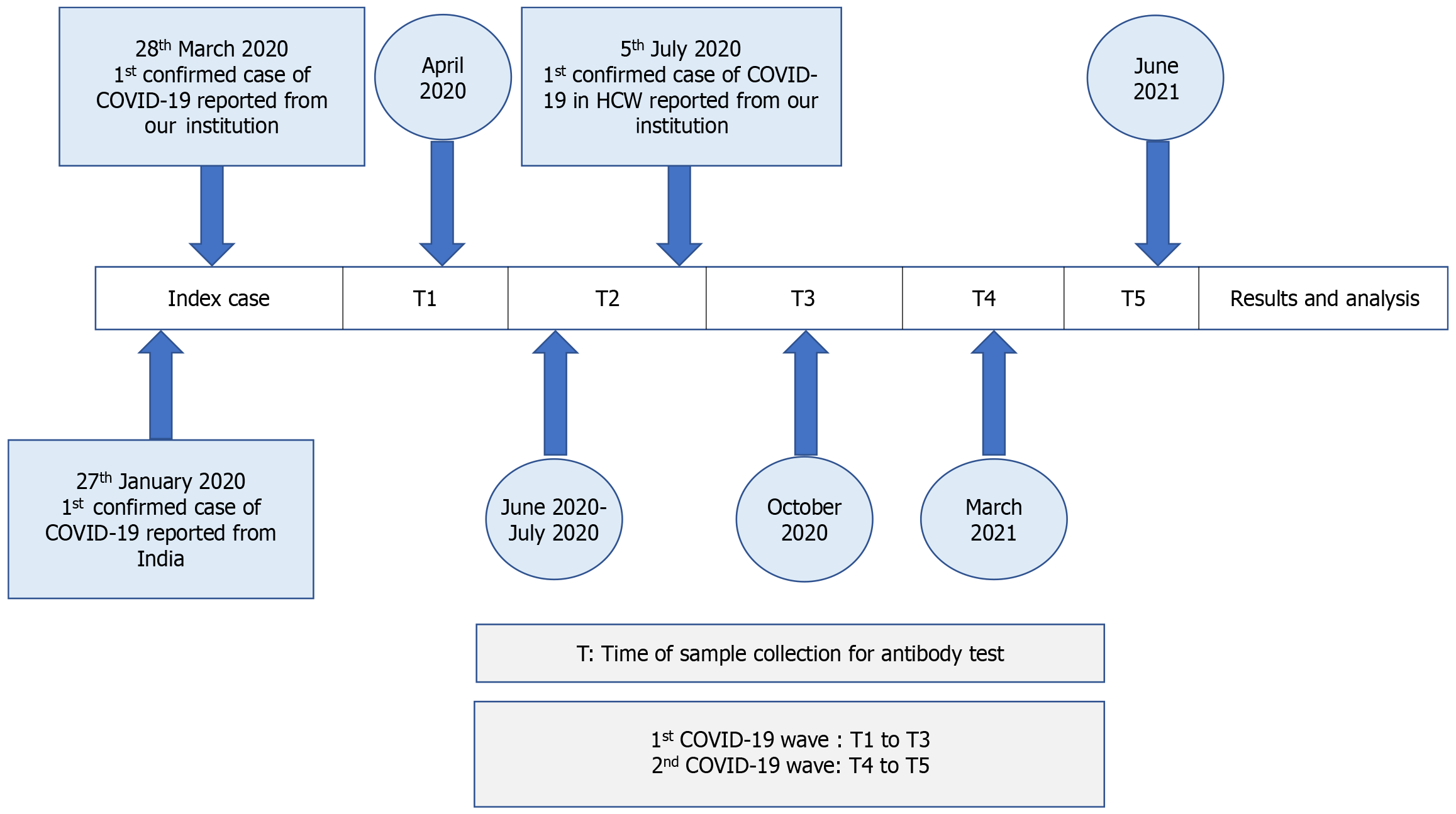Copyright
©The Author(s) 2025.
World J Virol. Jun 25, 2025; 14(2): 99663
Published online Jun 25, 2025. doi: 10.5501/wjv.v14.i2.99663
Published online Jun 25, 2025. doi: 10.5501/wjv.v14.i2.99663
Figure 1 The timeline of the study.
T1 to T5 reflects the five time points when sampling was done for the seroprevalence study. The first coronavirus disease 2019 (COVID-19) case was reported in India on 27th January 2020. The index case of COVID-19 was reported in our institution on 28th March 2020 while the first confirmed COVID-19 infection in a healthcare worker (HCW) was reported on 5th July 2020. The period T1 to T3 denotes the first wave of the pandemic during which time vaccine was not available. Vaccination for COVID-19 started in India for HCWs on January 16th, 2021. T4 and T5 denote the period when vaccination was rolled out in a phased manner and also reflects the period when the second wave of the pandemic occurred in India. COVID-19: Coronavirus disease 2019; HCW: Healthcare worker.
Figure 2 The seropositivity outcomes among healthcare workers working in high-risk and low-risk areas in our hospital.
High-risk areas refer to those working in the emergency department and/or the medical intensive care unit; low-risk (LR) areas refer to those working in paraclinical areas such as anatomy, physiology, biochemistry, or community medicine. Although healthcare workers (HCWs) in LR areas were not supposed to work in coronavirus disease 2019 (COVID-19) wards, they were requested to work in COVID-19 wards for short periods during the peak of the 2nd wave when the health system was overwhelmed with many patients. Clinical infection occurred among 120 of the 366 HCWs who were working in high-risk (HR) areas. Sero-study was done in 143 of the 366 HCWs in HR areas. At the end of the study 66.4% were positive for nucleocapsid antibodies and 97.9% were positive for spike antibodies. Among HCWs working in LR areas, 22 of the 82 HCWs developed clinical infection. At the end of the study 59.3% were positive for nucleocapsid antibodies and 94.9% were positive for spike antibodies. 1Only 202 HCWs who gave at least one sample for antibodies during the second wave (T4 or T5) and at least one baseline or T2 or T3 sample, and those who were unvaccinated or were vaccinated with COVISHIELD™ were included for the analysis on sero-study outcome. HCWs who were vaccinated with COVAXIN® were excluded from the sero-study analysis as it triggers nucleocapsid and spike antibodies and mimics infection. Clinical outcomes were followed up for all 448 HCWs.
- Citation: Abhilash KPP, Nellimootil MV, Chacko B, Hazra D, Coelho V, Jesudasan JE, Gunasekaran K, Thomas L, Ramchandra MA, Melchizedek J, Gunaraj HM, Moorthy M, Peter JV. Risk of COVID-19 infection among frontline healthcare workers during the COVID-19 pandemic. World J Virol 2025; 14(2): 99663
- URL: https://www.wjgnet.com/2220-3249/full/v14/i2/99663.htm
- DOI: https://dx.doi.org/10.5501/wjv.v14.i2.99663














